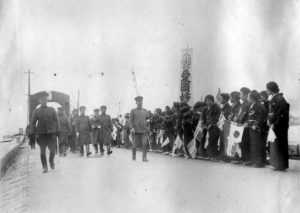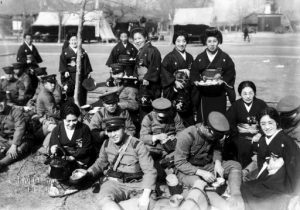Striving to fill voids in Hiroshima—Recreating cityscapes: Women’s Association serves tea to soldiers returning from China
Jan. 11, 2021
Military city Hiroshima’s Ujina Port
by Yuji Yamamoto, Staff Writer
Kimono-clad women stand in a line in front of a banner that reads “Patriotic women’s association,” while holding national flags of Japan in their hands. It is said that a photograph accompanying this article shows the women welcoming soldiers as they cross a pier designed for military use at Ujina Port (present-day Hiroshima Port, located in the city’s Minami Ward) after their return from mainland China in January 1933, about one year after the Manchurian (aka, Mukden) Incident.
Yoshihiro Kajiya, 84, a resident of Hiroshima’s Minami Ward, has held on to the photograph. It is one of 16 photos that remained in the photo album belonging to his deceased grandmother, Mae Kajiya. Another of the photos, with women serving tea to the soldiers outdoors, includes Mae herself in a traditional Japanese hairstyle. Enlarging the badge on a soldier’s collar in that photo allows the number “30” to be visible. The 30th Infantry Regiment out of Niigata Prefecture is known to have arrived at Ujina Port around the same time, a fact consistent with the information in the photo.
At the time, the Kajiya family produced and sold writing brushes in the area of Misasa-honmachi (now part of Hiroshima’s Nishi Ward). With the breakout of the Pacific theater of World War II in 1941, Mae evacuated to her family home in the area of Imayoshida (now part of Kitahiroshima, Hiroshima Prefecture). Her photo album escaped the fires that arose after the atomic bombing. After the atomic bomb was dropped, the military port of Ujina was used as a base from which the many wounded victims were taken to Ninoshima Island, off the coast.
Until recently, Mr. Kajiya had believed that all of Mae’s photos were taken on the West Drill Ground, located in the central part of Hiroshima. He asked Miwako Honda, curator at the Hiroshima City Museum of History and Traditional Crafts, in the city’s Minami Ward, to appraise the photos and learned they had been taken at a location that could be seen from his home in Minami Ward. He said, “From the photo, I was able to get a real sense of the old ‘military city of Hiroshima.’ I also recall memories of my kind grandmother.”
(Originally published on January 11, 2021)









